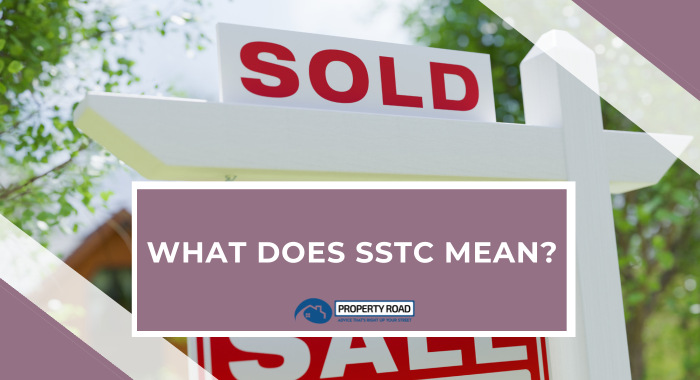Buying or selling a property in the UK involves a lot of confusing terms and processes, and one of the most commonly encountered phrases is Sold Subject to Contract or SSTC.
You may be asking, what does SSTC mean? Well, you’re right to question the importance of this label! If you’re new to navigating the world of buying a home, it’s essential to grasp the significance of this term and what it means for both buyers and sellers.
When we were looking for our first home, it was certainly one of the acronyms we didn’t understand!
Here, the Property Road team explains what SSTC means, along with its implications.
What does ‘Sold Subject to Contract’ mean?
Sold Subject to Contract is a status that a property is given once a buyer’s offer has been accepted by the seller, but legal contracts have not yet been exchanged.
Some agents will use the terms ‘sold STC’ or ‘sale agreed’. The usage of this terminology signifies that both parties have reached an agreement on the sale of the property. However, there are still some legal and administrative steps that need to be completed before the sale is finalised.
During the SSTC phase, the property is effectively off the market. In turn, other potential buyers are informed that an offer has been accepted.
You may also see ‘under offer’ used too. This can sometimes mean the same as SSTC, but is also sometimes used to indicate an offer has been made, but the sale is not yet progressing. This can happen if the buyer is not yet in a proceedable position but hopes to be soon.
Buying A Property? FREE Step-By-Step Platform
The stages of the SSTC process
The key to understanding what does SSTC mean and how it impacts the sale of a house, let’s look at the stages involved:
Offer acceptance
The journey towards SSTC begins when a potential buyer makes an offer on a property. Once the seller accepts the offer, the property’s status changes to SSTC. At this point, both parties have a verbal agreement to proceed with the sale, but no legally binding contracts have been exchanged.
By ensuring a property is marked as SSTC once you’ve had an offer accepted, you help to put off people from trying to gazump you. That’s why we always make a point of requesting a property is marked as SSTC as soon as we’ve had an offer accepted.
Conveyancing and legal process
After the offer is accepted, the legal process known as conveyancing kicks in. Conveyancing involves a series of legal checks, searches and paperwork to ensure the property’s title is clear and there are no hidden issues or liabilities.
The buyer’s solicitor works closely with the seller’s solicitor to address any legal aspects and draft the contract.
This is also the process that might bring up concerns that the buyer will want to address, such as the seller contributing to roof repair, for instance. Or they might decide to pull out after the searches have been completed.
Survey and mortgage approval
The buyer typically arranges a property survey to assess the condition of the property. This helps the buyer understand if there are any structural issues or repairs needed. Also, if the buyer requires a mortgage to fund the purchase, the mortgage lender will conduct a valuation and assess the mortgage application.
Exchange of contracts
The critical moment in the SSTC process is the exchange of contracts. This step involves the buyer and seller signing the legally binding contract, which outlines the terms of the sale.
A deposit is usually paid by the buyer at this stage. Once the contracts are exchanged, the sale becomes legally binding, and the property status changes from SSTC to ‘Sold’.
Completion
Completion is the final stage of the process. It’s the day when ownership of the property officially transfers from the seller to the buyer. This is when the funds are transferred, and the buyer gains access to the property.
Can you still view a house that is labelled as SSTC?
Usually, you can still view a house that is marked as sold STC, but there are certain factors to consider and limitations to be aware of.
The main point is that until the legal contracts are exchanged, and the sale becomes legally binding, there is still a possibility that the sale could fall through.
That means some sellers and estate agents may continue to allow viewings of the property even after it’s marked as SSTC, especially if they want to have a backup option in case the current sale doesn’t proceed.
If you still want to view a home that is SSTC, then you need to understand:
The estate agent’s policy
The decision to allow viewings of an SSTC property can vary depending on the estate agent and the seller’s preferences. Some may continue to show the property to potential buyers, while others might temporarily suspend viewings until the situation becomes more certain.
We once requested a viewing a property that was marked as SSTC simply because we loved it and didn’t want to miss out if the transaction wasn’t proceeding well. Unfortunately, the vendor wasn’t prepared to accept any further viewings as they were close to completing the conveyancing process.
As much as it was disappointing, we understood and knew that we might not be able to view the property as it was SSTC.
Transparency
If you’re interested in viewing an SSTC home, it’s a good idea to contact the estate agent and inquire about the property’s status. They can provide you with information about whether viewings are still being conducted and any conditions or restrictions that might apply.
We’ve also found it’s a good idea to be completely open about your position too. If you’re not in a chain this might make you more attractive as a buyer and improve your chances of being able to view a SSTC property.
Timing
Keep in mind that if viewings are still allowed for an SSTC property, the seller and their agent might be dealing with a delicate situation. Be respectful of this and any potential uncertainty they’re facing.
We’ve found that when properties have only just been changed to SSTC, you can often be allowed to view them. However, if they have been marked as SSTC for a while, we rarely get the chance to view them unless there is a problem preventing the agreed sale proceeding.
Due diligence
Even if you’re allowed to view an SSTC property, it’s important to continue your due diligence. Investigate the property thoroughly, conduct surveys if necessary, and ensure you’re financially and legally prepared if you decide to make an offer.
Remember that the property market can be fluid, and situations can change. An SSTC property might eventually move to completion, or the sale might fall through, reopening the property for new offers.
If you’re interested in a property that’s marked as Sold Subject to Contract, it’s a good idea to stay in communication with the estate agent and be prepared to act quickly if the opportunity arises.
You could also make a ‘back-up offer’ should the current deal fall through. We have done this on properties we have really liked but that went under offer before we were proceedable. It helps to put you first in line if something happens to the agreed transaction.

Gazumping
Having looked at the situation when a property is marked as SSTC, but viewings are still taking place means a credible, higher offer might be made.
This is called gazumping which sees a buyer enter the fray and offer more money than the current bid.
Because legal contracts haven’t been exchanged, the seller can still accept a higher offer.
In a market where house prices are rising quickly, gazumping is prevalent.
If you are a buyer and want to avoid being outbid after making an offer, see below.
How long will a property remain as SSTC?
There is no simple answer to the question: ‘How long will a property remain as SSTC?’
That’s because the conveyancing process will take as long as it needs – but this will usually be around 9-12 weeks. Sometimes this will be longer, and the buyer may have to chase both sets of solicitors to progress the sale.
Implications for buyers and sellers
There are some implications about the SSTC process for both the seller and the buyer. They include:
For sellers
Being ‘Sold Subject to Contract’ signifies a positive step towards completing the sale of a property. It means that a buyer has expressed serious interest and the seller has accepted their offer.
However, until contracts are exchanged, the sale isn’t guaranteed. During the SSTC phase, you’re still obliged to disclose any material information about the property to the buyer and proceed with the legal and administrative steps.
For buyers
As a buyer, an SSTC property means that another buyer has secured an agreement with the seller. While the property is technically off the market, there’s still a chance for the sale to fall through before contracts are exchanged.
During this period, the buyer will need to continue with their due diligence, surveys and sourcing a mortgage. But don’t be surprised to see that the property is still marketed by the agent despite the SSTC property being added to the sale board.
Most rival buyers will, however, be put off from looking at a property that is marked as ‘sold STC’. You could, when making an offer, insist that the property should be taken off the market to avoid being gazumped. This is also a way of having the seller show some faith in selling to you.
The bottom line for sold STC implications is that both the buyer and seller will need to be prepared for any unexpected issues that may arise during the conveyancing process.
There might be unexpected results from the solicitor’s search, or the buyer’s financial circumstances might change.
What does SSTC mean?
While ‘Sold Subject to Contract’ is an important phase in the property buying and selling process – it doesn’t mean that another buyer is prevented from making a higher offer.
The term SSTC simply indicates that an offer has been accepted and both parties are on the path to completing the sale, but legalities and administrative procedures must be fulfilled before the process is finalised.
As a seller, they are one step closer to handing over the keys, and the buyer is one step closer to becoming the owner of a property.
Essentially, SSTC is a milestone that highlights progress, but it’s essential to stay diligent until the contracts are exchanged and completion is achieved.
With a clear understanding of the SSTC process, both buyers and sellers can navigate the property selling and buying journey with confidence and clarity.





